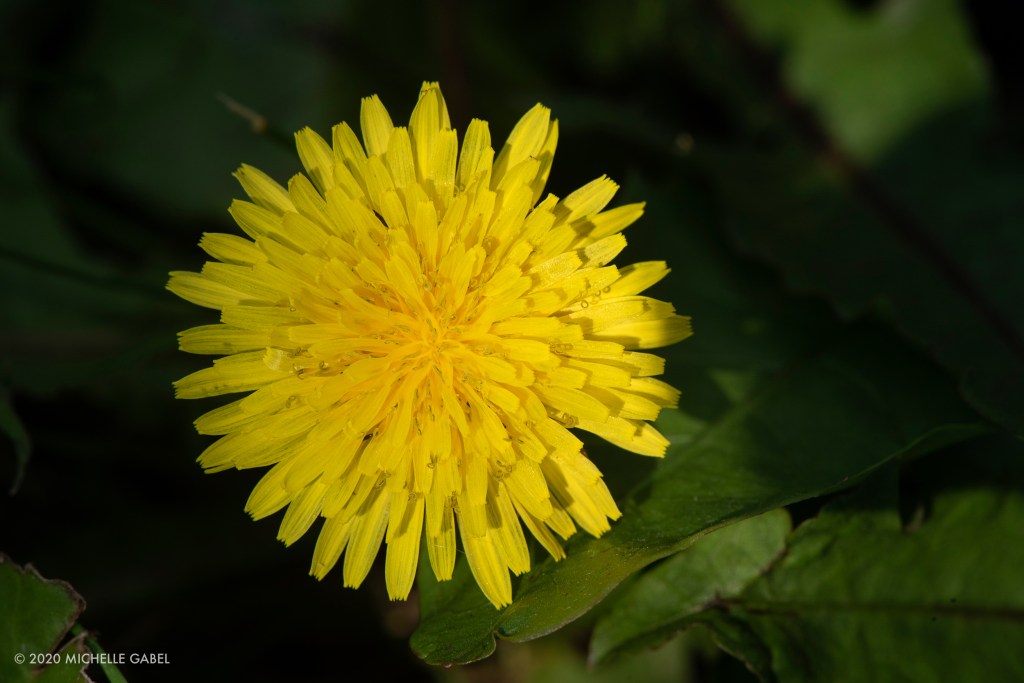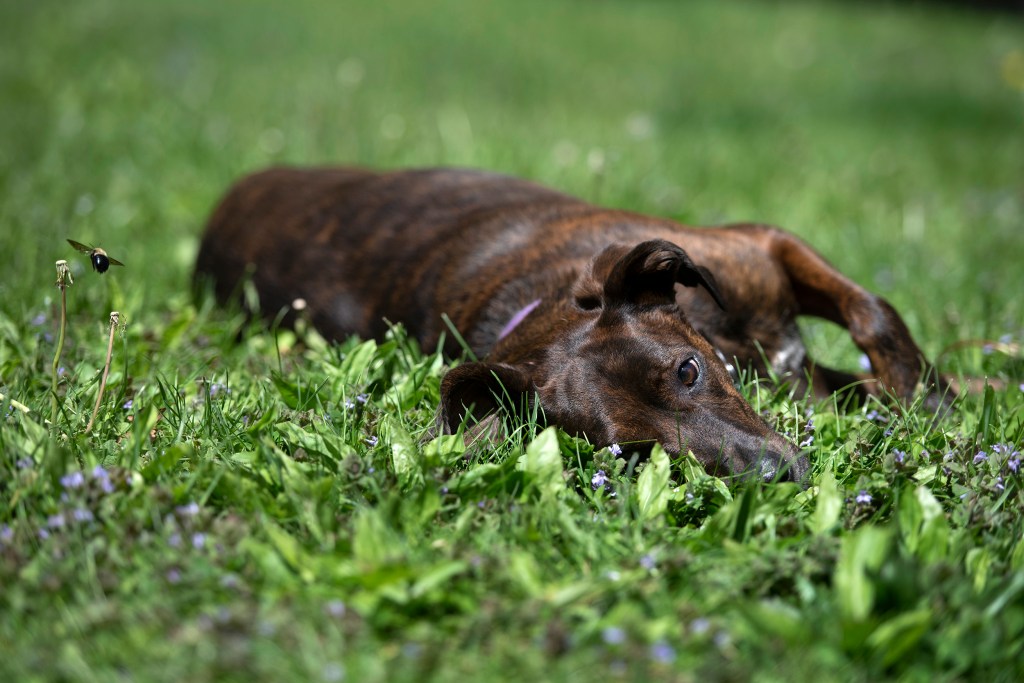
By ALLISON SKLANEY
The color of the sun, perky and plentiful, the dandelion evokes emotion, usually a negative one. Brought to America by European settlers, the once prized dandelion is now perpetually rooted up and sprayed with chemicals. In a culture where curbside appeal equals the two-inch grass of a golf course, the starry shaped dandelion has become a symbol of neglect.

In upstate New York, I walk around my yard and watch the chubby, wild rabbits feast on the bright yellow “lion’s teeth,” as bumblebees and butterflies clumsily pollinate the early spring flowers. Chipmunks eat wild strawberries as robins and Carolina wrens wrestle worms and grubs out of the soil.
I wonder at the life all around me. In a time of worldwide environmental vulnerability, I feel peace with the biodiversity flourishing in my yard. I don’t think of the sturdy, deep-rooted dandelions as troublesome weeds, but as fertilizer for the grass, food for wildlife and first aid for my family.
When my husband and I moved here from New York City 13 years ago, we weren’t sure how to take care of our new yard. We saw the neatly trimmed lawns of our neighbors, heard lawnmowers going from morning until night, spring until fall. We weren’t excited about mowing the lawn every week, but we definitely felt a pressure to maintain the standard look of the neighborhood, and I admit I was ashamed of the quickly multiplying dandelions.
We watched as lawn care companies patrolled the neighborhood, knocked on doors, sprayed lawns with chemicals and put up yellow signs warning passersby to stay off the grass for 24 hours. As our toddlers played outside, and tumbled off bicycles and scooters into neighbors’ yards, I felt worried about the pesticide signs.
I knew enough about science to know that chemicals don’t break down right away. They can aerosolize, drifting across the lawns, or wash into storm drains, nearby creeks and the water supply during a rainstorm. But even if they remain put, the chemicals do more than kill weeds: they destroy the microorganisms that live in the soil, affecting the health of the soil and ultimately everything that depends on it.
At the grocery store, organic food sales have reached almost $50 billion in the United States. Consumers spend extra to buy fruit, vegetables and grains grown without pesticides yet paradoxically they buy 59 million pounds of pesticides for the lawn. The most popular and heavily applied is glyphosate, which is used on more than 100 food crops and is the active ingredient in many weedkillers, including RoundUp.

Introduced in 1974, glyphosate has been considered a low hazard to mammals for decades, although in 2015 the World Health Organization’s International Agency for Research on Cancer (IARC) re-classified glyphosate as “probably carcinogenic to humans” based on epidemiological, animal and in vitro studies. Other agencies, such as the EPA, have stated that “there are no risks of concern to human health when glyphosate is used according to the label” but admit that glyphosate-based formulations (GBFs) may be more toxic.
It’s not easy to figure out the ingredients of weedkillers. Aside from the active ingredient, all that’s listed on the label is “other ingredients.” In several studies glyphosate-based formulations have been shown to negatively affect mammalian biology. Exposure has been associated with kidney and liver damage in rodents, arrhythmias, endocrine disruption and electrophysiological changes in rats and rabbits.
There have been many studies on the effects of GBFs on humans, and despite a couple of studies that found a statistically significant positive meta-RR for B-cell lymphoma, the consensus is that there is no determined causal relationship. Despite this, tens of thousands of lawsuits have been filed against Bayer, the company that sells RoundUp. On June 24, Bayer agreed to pay around $10 billion to settle the cases. RoundUp remains on the market.
As a result of herbicide use, lawn care companies and homeowners often use synthetic inorganic fertilizers to bring nutrients back to their lawns. Unfortunately man-made fertilizers containing nitrogen, phosphorous and potassium are risky to the environment. Not only are they often derived from oil products, but they are then mixed with ammonia, urea and formaldehyde.

While the EPA says synthetic fertilizers are safe to use as directed, overuse and runoff of nitrogen and phosphorous into wells, lakes and oceans have led to oxygen depletion. Babies exposed to contaminated well water can literally be starved of air by developing a condition known as methemoglobinemia. Lakes and oceans can develop “dead zones” where fish cannot breathe because the overgrowth of blue-green algae consumes oxygen faster. Cultural or human-induced eutrophication is due to an increase of phosphorus mainly, but also nitrogen, as it builds up in fresh waters from fertilizers and sewage treatments.
While individual use of weed killers and fertilizers on the lawn once or twice a year isn’t the sole cause of damaged ecosystems, sick wildlife or cancer, it’s the cumulative effect of many individuals and big agriculture that is worrisome. According to the EPA, the U.S. uses over a billion pounds of pesticides a year. We should all be concerned that there are pesticides in our water, on our food and inside our bodies.
In a study conducted by the EPA, 46 pesticides were found in groundwater in 26 states due to agricultural applications. The Environmental Working Group, a nonprofit advocacy group, deduced that around 70 percent of U.S. produce contains pesticides. According to the National Institute of Health more than 90% of the U.S. population has pesticide biomarkers in their urine or blood. With so much chemical exposure outside of our control, the question becomes why add more chemicals to the mix by spraying our lawns with toxic herbicides?
There’s 40-50 million acres of private lawn in the United States — that’s a whole lot of potential for creating healthy ecosystems. Without pesticides in the grass, lawns become a safer place for children, who are more susceptible to chemical exposure, to play with beloved pets. It’s true that dandelions will flourish, as do strawberry plants, clover and all kinds of native plant species, but consider the insects, birds and mammals who will benefit.

Let’s think of the sunny dandelions as a gift, a reminder that there’s a whole lot of work to be done in learning how to care for our green space naturally. With the future health of the Earth and ourselves in mind, the dandelion can once again be a symbol of patience, love and healing. But every once in a while, feel free to manually pull out a particularly big one or squirt it with a dose of vinegar.
Tips to keep your lawn healthy without chemicals
- Cut the grass more frequently at a higher setting (don’t remove more than one third of the leaf).
- Return grass clippings back to the lawn to add nutrients like nitrogen.
- Aerate turf when soil is moist, not wet, to allow air to into the soil, to improve drainage and breakup compaction. Better aerated soil has more microbial activity reducing thatch and stimulating root growth.
- Add garden or leaf compost, topsoil, sand or charcoal to the lawn for extra nutrients when soil is dry during growing season. Take care to brush it in evenly so you don’t smother the grass.
- Intermix native perennial plants and flowers with the grass to enrich soil with billions of microorganisms (fungi and bacteria). Legumes such as clover attract nitrogen-fixing bacteria, which convert atmospheric nitrogen to fertilizer.
- Check your soil’s pH. You can buy a test kit at the hardware store or contact your local Cooperative Extension Service. Slightly acid to neutral pH (6.5-7.0) is good for most grass types. You can add sulfur to make the soil more acidic, lime to make it more neutral.
- Water consistently or don’t water at all.
Risks of glyphosate-based products
The pesticide glyphosate is the active ingredient in many weedkillers.
The EPA has set the glyphosate limit at .75 mg per kilogram body weight per day, but there is no safe limit determined for chemical mixtures. A recent study by the National Toxicology Program at the U.S. Department of Health and Human Services found genotoxic activity in glyphosate-based formulations (GBFs) with diquat dibromide, metolachlor and mesotrione.
It’s not just glyphosate-based herbicides that have disturbing health risk associations. Another popular one, 2,4-dichlorophenoxyacetic acid (2,4-D), has been linked to a higher bladder cancer risk in dogs and risk of Parkinson’s disease, immunosuppression, non-Hodgkin lymphoma, hypothyroidism and lower sperm counts in humans. The Centers for Disease Control and Prevention says that the human health effects from 2,4-D at low environmental doses are unknown but that it has “low acute toxicity.”
Allison Sklaney teaches design and digital illustration at Syracuse University. Passionate about the environment, she thinks dandelions get a bad rap.

Someone once told me I should refer to my unruly grass as a “Freedom Lawn” 🙂
LikeLiked by 1 person
That applies to ours, as well!
LikeLike
Don’t forget the clover. The bees love it.
LikeLike
Very informative! For my Italian family, dandelion greens were poor people’s arugula.
LikeLiked by 1 person
Here’s another reason to love dandelions: https://www.goodnewsnetwork.org/dandelions-produce-more-sustainable-rubber/?fbclid=IwAR0hlcwrV67jqFcqF8Fbmxsttx-ZSMxq3RVDjT96tz0Edry182IAFpJCs30#.YKV5SmX6AQs.facebook
LikeLike
I find it inspiring that you have chosen to embrace biodiversity and natural lawn care practices.
LikeLiked by 1 person